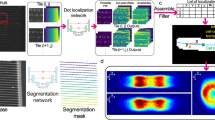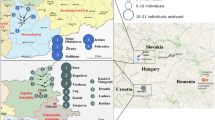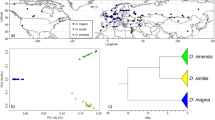Abstract
Chromosome polymorphism in Drosophila buzzatii is under selection but the genes responsible for the effect of the inversions on fitness are unknown. On the other hand, there is evidence for selection on several allozyme loci but the presence of paracentric inversions on the second chromosome, where most of the polymorphic loci are located, complicates the interpretation. Studies of the associations between allozymes and inversions are thus necessary to help understand the effect of selection at both the chromosomal and allozymic level. Until now this kind of information has only been available in D. buzzatii for two loci, Est-1 and Est-2, in Australian populations. Here we describe the genetic constitution of two Old World populations, Carboneras and Colera. Emphasis has been placed on the analysis of the linkage disequilibria between the second chromosome arrangements and three allozyme loci, Est-2, Pept-2 and Aldox, located on this chromosome. In addition, the recombination frequencies between the loci, and between the loci and the inversion breakpoints, have been estimated and a genetic map of the three loci has been produced. The two populations differ in allele and arrangement frequencies, as well as in the pattern of one-locus disequilibria. Est-2 and Aldox are associated with the second chromosome arrangements in both populations. On the other hand, Pept-2 is associated with the inversions in Colera but not in Carboneras. The gametic associations among the three loci are discussed taking into account the position of these loci on the chromosome map and the lack of recombination in the heterokaryotypes.
Similar content being viewed by others
Article PDF
References
Backeberg, C. 1977. Cactus Lexicon Enumerative Diagnostica Cactaccearum. Blandford Press, Poole, England.
Barbadilla, A, Ruiz, A, Santos, M, and Fontdevila, A. 1994. Mating pattern and fitness component analysis associated with inversion polymorphism in a natural population of Drosophila buzzatii. Evolution (in press).
Barbadilla, A, Quezada-Díaz, J E, Ruiz, A, Santos, M, and Fontdevila, A. 1991. The evolutionary history of Drosophila buzzatii. XVII. Double mating and sperm predominance. Genet Sel Evol, 23, 133–140.
Barker, J S E. 1981. Selection at allozyme loci in cactophilic Drosophila. In: Gibson, J. B. and Oakeshott, J. G. (eds) Genetic Studies of Drosophila Populations. Proceedings of the 1979 Kiola Conference, pp. 161–184. Australian National University, Canberra.
Barker, J S F, and East, P D. 1980. Evidence for selection following perturbation of allozyme frequencies in a natural population of Drosophila. Nature, 284, 166–168.
Barker, J S F, East, P D, and Christiansen, F B. 1989. Estimation of migration from a perturbation experiment in natural populations of Drosophila buzzatii Patterson & Wheeler. Biol J Linn Soc, 37, 311–334.
Barker, J S F, East, P D, and Weir, B S. 1986. Temporal and microgeographic variation in allozyme frequencies in a natural population of D. buzzatii. Genetics, 112, 577–611.
Barker, J S F, Sene, F, East, M, and Pereira, M A Q R. 1985. Allozyme and chromosomal polymorphism of Drosophila buzzatii in Brazil and Argentina. Genetica, 67, 161–170.
Bennet, J H. 1954. On the theory of random mating. Ann Eugen, 18, 311–317.
Betrán, E. 1992. Efecte del Polimorfisme d'Inversions i Allozímic sobre Caràcters Quantitatius en una Població de Drosophila buzzatii. Master's thesis, Universitat Autönoma de Barcelona.
BMDP. 1988. Statistical Software. University of California Press, Berkeley.
Britton, N L, and Rose, J N. 1963. The Cactaceae. Dover Publications, New York.
Charlesworth, B. 1974. Inversion polymorphism in a two-locus genetic system. Genet Res, 23, 259–280.
Crow, J F, and Kimura, M. 1970. An Introduction to Population Genetics Theory. Harper and Row, New York.
CSS statisticaTM. 1991. Statsoft of Europe, Hamburg.
David, J R, and Bocquet, C. 1975. Similarities and differences in latitudinal adaptation of two Drosophila sibling species. Nature, 257, 588–590.
David, J, and Tsacas, L. 1980. Cosmopolitan, subcosmopolitan and widespread species: different strategies within the Drosophilid family (Diptera). C R Soc Biogéogr, 57, 11–26.
Edlant-Johnson, R C. 1971. Probability Models and Statistical Methods in Genetics. J. Wiley, New York.
Fontdevila, A. 1981. Çuánto polimorfismo se pierde en la colonización? Simposia Genética y Ecol Especiación Animal, pp. 69–99. Universidad Simón Bolivar, Venezuela.
Fontdevila, A. 1989. Founder effects in colonizing populations: the case of Drosophila buzzatii. In: Fontdevila, A. (ed.) Evolutionary Biology of Transient Unstable Populations, pp. 74–95. Springer, Berlin.
Fontdevila, A, Ruiz, A, Alonso, G, and Ocaña, J. 1981. The evolutionary history of Drosophila buzzatii. I. Natural chromosomal polymorphism in colonized populations of the Old World. Evolution, 35, 148–157.
Fontdevila, A, Ruiz, A, Ocaña, J, and Alonso, G. 1982. The evolutionary history of Drosophila buzzatii. II. How much has polymorphism changed in colonization? Evolution, 36, 843–851.
Gaffney, P M, Scott, T M, Koehn, R K, and Diehl, W J. 1990. Interrelations of heterozygosity, growth rate and heterozygote deficiencies in the Coot Clam, Mulinia lateralis. Genetics, 124, 687–699.
Hassón, E, Fanara, J J, Rodríguez, C, Vilardi, J C, Reig, O A, and Fontdevila, A. 1992. The evolutionary history of Drosophila buzzatii. XXIV. Second chromosome inversions have different average effects on thorax length. Heredity, 68, 557–563.
Ishh, K, and Charlesworth, B. 1977. Associations between allozyme loci and gene arrangements due to hitch-hiking effects of new inversions. Genet Res, 30, 93–106.
Knibb, W R, and Barker, J S F. 1988. Polymorphic inversion and esterase loci complex on chromosome 2 of Drosophila buzzatii. II. Spatial variation. Aust J Biol Sci, 41, 239–246.
Knibb, W R, East, P D, and Barker, J S F. 1987. Polymorphic inversion and esterase loci complex on chromosome 2 of Drosophila buzzatii. I. Linkage disequilibria. Aust J Biol Sci, 40, 257–269.
Labrador, M, Naveira, H, and Fontdevila, A. 1990. Genetic mapping of the Adh locus in the repleta group of Drosophila by in situ hybridization. J Hered, 81, 83–86.
Lewontin, R C. 1964. The interaction of selection and linkage. I. General considerations: heterotic models. Genetics, 49, 49–67.
Lewontin, R C, and Kojima, K. 1960. The evolutionary dynamics of complex polymorphisms. Evolution, 14, 458–472.
Loukas, M, and Krimbas, C B. 1980. Isozyme techniques in Drosophila subobscura. Drosoph Inf Serv, 55, 157–158.
Loukas, M, Krimbas, C B, and Vergini, Y. 1979. The genetics of Drosophila subobscura populations. IX. Studies on linkage disequilibrium in four natural populations. Genetics, 93, 497–523.
Montchamp-Moreau, C, and Katz, M. 1986. A theoretical analysis of linkage disequilibrium produced by genetic drift in Drosophila populations. Genet Res, 48, 161–166.
Nei, M, and Li, W. 1980. Non-random association between electromorphs and inversion chromosomes in finite populations. Genet Res, 35, 65–83.
Pamilo, P, and Varvio-Aho, S. 1994. Testing genotype frequencies of heterozygosities. Mar Biol, 79, 99–100.
Pereira, M A Q R, Vilela, C R, and Sene, F M. 1983. Notes on breeding and feeding sites of some species of the repleta group of the genus Drosophila (Diptera, Drosophilidae). Ciência e Cultura, 35, 1313–1319.
Prevosti, A. 1955. Variacion geografica de caracteres cuantitativos en poblaciones británicas de Drosophila subobscura. Genét Ibér, VII, 3–44.
Quezada-Díaz, J E. 1993. Estructura Poblacional y Patrón de Apareamientos de la Especie Cactófila Drosophila buzzatii. Ph.D. Thesis. Universitat Autònoma de Barcelona, Spain.
Quezada-Díaz, J E, Santos, M, Ruiz, A, and Fontdevila, A. 1992. The evolutionary history of Drosophila buzzatii. XXV. Random mating in nature. Heredity, 63, 373–379.
Robinson, W P, Asmussen, M A, and Thomson, G. 1991. Three-locus systems impose additional constraints on pairwise disequilibria. Genetics, 129, 925–930.
Ruiz, A. 1982. El Polimorfismo de Inversiones en Drosophila buzzatii. Ph.D. Thesis. Universidad de Santiago de Compostela. Santiago de Compostela, Spain.
Ruiz, A, and Fontdevila, A. 1985. The evolutionary history of Drosophila buzzatii. VI. Adaptive chromosomal changes in experimental populations with natural substrates. Genetica, 66, 63–71.
Ruiz, A, Fontdevila, A, Santos, M, Seoane, M, and Torroja, E. 1986. The evolutionary history of Drosophila buzzatii. VIII. Evidence for endocyclic selection acting on inversion polymorphism in a natural population. Evolution, 40, 740–755.
Ruiz, A, Naveira, H, and Fontdevila, A. 1984. La historia evolutiva de Drosophila buzzatii. IV. Aspectos citogeneticos de su polimorfismo cromosomico. Genét Ibér, 36, 13–35.
Ruiz, A, and Santos, M. 1989. Mating probability, body size, and inversion polymorphism in a colonizing population of Drosophila buzzatii. In: Fontdevila, A. (ed.) Evolutionary Biology of Transient Unstable Populations, pp. 96–113. Springer, Berlin.
Ruiz, A, Santos, M, Barbadilla, A, Quezada-Díaz, J E, Hasson, E, and Fontdevila, A. 1991. Genetic variance for body size in a natural population of Drosophila buzzatii. Genetics, 128, 739–750.
Ruiz, A, Santos, M, and Fontdevila, A. 1987. Differential response to environmental alcohol among second-chromosome arrangements in experimental populations of Drosophila buzzatii. Genetica, 75, 219–229.
Ruiz, A, and Wasserman, M. 1993. Evolutionary cytogenetics of the Drosophila buzzatii species complex. Heredity, 70, 582–596.
Santos, M. 1994. Heterozygote deficiencies under Levene's population subdivision structure. Evolution (in press).
Santos, M, Ruiz, A, Barbadilla, A, Quezada-Díaz, J E, and Fontdevila, A. 1988. The evolutionary history of Drosophila buzzatii. XIV. Larger flies mate more often in nature. Heredity, 61, 255–262.
Santos, M, Ruiz, A, and Fontdevila, A. 1989. The evolutionary history of Drosophila buzzatii. XIII. Random differentiation as a partial explanation of chromosomal variation in a structured natural population. Am Nat, 133, 183–197.
Santos, M, Ruiz, A, Quezada-Díaz, J E, Barbadilla, A, and Fontdevila, A. 1992. The evolutionary history of Drosophila buzzatii. XX. Positive phenotypic covariance between field adult fitness components and body size. J Evol Biol, 5, 403–422.
Schafer, D J, Fredline, D K, Knibb, W R, Green, M M, and Baker, J S F. 1993. Genetics and linkage mapping of Drosophila buzzatii. J Hered, 84, 188–194.
Slatkin, M. 1977. Gene flow and genetic drift in a species subject to frequent local extinctions. Theor Pop Biol, 12, 253–262.
Sokal, R R, Oden, N L, and Barker, J S F. 1987. Spatial structure in Drosophila buzzatii populations: simple and directional spatial autocorrelation. Am Nat, 129, 122–142.
Sokal, R R, and Rohlf, F J. 1981. Biometry, 2nd edn. Freeman, New York.
Wasserman, M. 1962. Cytological studies of the repleta group of the genus Drosophila. V. The mulleri subgroup. Studies in Genetics, II. Texas University Publishers, 6205, 119–134.
Watt, A W. 1981. The genetics of temperature tolerance in Drosophila buzzatii. In: Gibson, J. B. and Oakeshott, J. G. (eds) Genetic Studies of Drosophila Populations. Proceedings of the 1979 Kiola Conference, pp. 139–146. Australian National University, Canberra.
Weir, B S. 1990. Genetic Data Analysis. Sinauer, Sunderland, MA.
Yamaguchi, O, Ichinose, M, Matsuda, M, and Mukai, T. 1980. Linkage disequilibrium in isolated populations of Drosophila melanogaster. Genetics, 96, 507–522.
Yamazaki, T. 1977. The effects of overdominance on linkage in a multilocus system. Genetics, 86, 227–236.
Zouros, E, and Krimbas, C B. 1973. Evidence for linkage disequilibrium maintained by selection in two natural populations of Drosophila subobscura. Genetics, 73, 659–674.
Author information
Authors and Affiliations
Rights and permissions
About this article
Cite this article
Betrán, E., Quezada-Díaz, J., Ruiz, A. et al. The evolutionary history of Drosophila buzzatii. XXXII. Linkage disequilibrium between allozymes and chromosome inversions in two colonizing populations. Heredity 74, 188–199 (1995). https://doi.org/10.1038/hdy.1995.27
Received:
Issue date:
DOI: https://doi.org/10.1038/hdy.1995.27



